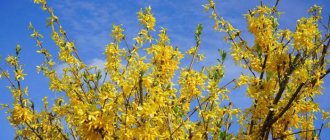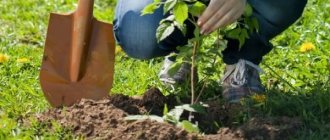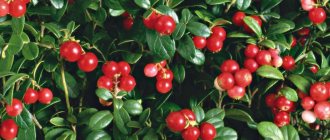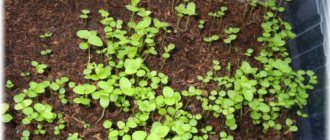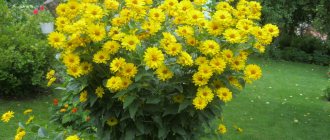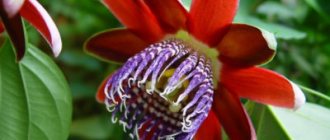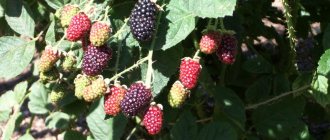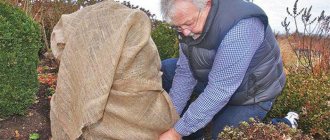The fashion for exotics is growing every year. If a couple of years ago, we did not know where to buy seeds and seedlings of this or that exotic, now unusual plants from warmer climatic zones are widely adapted to our region.
This also applies to the plane tree, one of the oldest trees.
Several thousand years ago, the ancient Greeks and Persians called it the most beautiful tree of the East. And today everyone can grow a plane tree at their dacha or on an estate, because it is not so difficult to do.
Description of the genus
Sycamore has a very high life expectancy. It lasts 800-1000 years, and some species live up to 2000 years and above. In addition, it is distinguished by its large size; it is not for nothing that “sycamore” is translated from Greek as “wide”. The tree grows throughout its life. This is due to the active production of cambium. This is an educational tissue in the stems and root system, providing thickening of the woody layer. The formation of the organic polymer lignin in wood helps to increase its strength and quality.
The height of the trunk can reach 50 m, and the diameter of the trunk is 8 m. It is protected by a dense layer of greenish or brown bark. The tree sheds its mature bark in thin sheets, revealing a young yellow-green surface. This property helps the plant not to accumulate toxins and withstand the unhealthy atmosphere of the city, oversaturated with exhaust gases.
The leaves of the plane tree are large, can reach 30 cm in length. They resemble maple leaves in shape - palmately lobed, dense, attached to long petioles.
In spring, the bright bush looks very impressive. Its branches are covered with clusters of small female and male flowers on long peduncles. Flowering soon gives way to fruiting. Numerous multinut fruits are small cone-shaped balls covered with stiff bristles. They consist of a mass of small fruit heads with seeds, united by a hard pericarp. The fruits do not leave the tree even after the leaves fly off. And only next spring they break up into individual seeds and are carried by the wind.
They form a crown up to 40 meters in diameter.
2. Sycamore has other names: plane tree, eastern maple, button tree.
3. The plane tree is a deciduous plant. The species is distinguished by a wide spreading crown and a high, up to 45-60 meters, trunk. The circumference of an adult tree can be 18-20 meters.
4. There are evergreen varieties, which include platanus kerrii.
5. The sycamore tree is widespread in countries with hot climates, where plantings grow very quickly, do not require maintenance and provide coolness.
6. The trunk of plane trees is covered with greenish bark, which over time peels off in large layers, resulting in a bizarre pattern on the surface.
7. The leaves of the plane tree are large. The leaf length is up to 20 centimeters. There are up to seven blades on one leaf. Outwardly, they resemble maple leaves. Young plants have densely pubescent leaves.
8. Sycamore is a dioecious plant. Small flowers are collected in multi-capitate inflorescences. Male flowers are yellow, collected in large spherical inflorescences, female flowers are bright red. Flowers bloom simultaneously with leaves in late April - early May.
9.The fruiting period begins after six years. The fruits of the plane tree are nuts collected in round fruits of greenish-brown color. The ripening period occurs at the beginning of autumn. They remain on the branches almost all winter.
10. The seeds of the sycamore tree are small. Near the base of each seed there is a small bunch of hard outgrowths. After ripening, the seeds are carried by the wind over long distances.
11. Plane tree is widespread in the countries of America, East Asia, and the Mediterranean.
12.Wild specimens grow along the banks of rivers and reservoirs, forming small groves.
13.Currently there are about 10 species of sycamore tree. The main difference between the types of sycamore tree is the appearance of the leaves and fruits.
14. Wild species and hybrid varieties are known.
PLATEANUS COMMON
15. The common plane tree reaches a height of 35-40 meters, forming a round crown. This plant grows very quickly.
16. Sycamore has been widespread in North America since the late 18th century.
16.The American or Western sycamore is the largest variety. The height of individual specimens can reach a height of up to 50 meters. Leaves are 3-5-lobed. The inflorescences are single capitate.
17. This type of plane tree is most common in Western Europe, Belarus, Stavropol, Dagestan, and Adygea.
18. Oriental plane tree leaves have narrow blades. The edges of the leaf blade are slightly jagged. Flowers are collected in complex multi-capitate inflorescences.
19.Eastern plane tree grows in Crimea, Ukraine, Central Asia, and Moldova.
PLANE MAPLELEAF
20. London sycamore, or maple-leaved, is a hybrid variety of western and eastern species, which is distinguished by long, five-lobed leaves, reaching a length of 20 centimeters and having a heart-shaped base. This species is resistant to low temperatures and tolerates winter frosts.
21. This type of plane tree is grown in the Caucasus, Armenia, and Crimea.
22. This tree has long been revered as sacred. In Ancient Egypt, it served as a symbol of the sky, and was dedicated to the goddess Nut.
23. In ancient times, there were plane trees, under the shade of each of which up to 100 horsemen could hide.
24. In hot countries, plane trees are highly valued, because they provide life-saving shade and coolness. It’s not for nothing that broad-leaved plane trees are called “shade trees.”
25. Sycamore is a tall and powerful long-living tree - there are specimens that are more than 1000 years old.
26. In its habitats there are unique specimens that are more than 2 thousand years old.
27. The oldest and largest plane tree grows in Turkey in the Buyukdere Valley. The height of the plane tree is 50 meters, the diameter of the trunk is 13.4 meters, the circumference of the trunk is 42 meters, the age of this plane tree is more than 2300 years.
PLANE "SEVEN BROTHERS"
28. In Turkmenistan, the plane tree grows, which is called “seven brothers”, because its trunk split into 7 huge branches that support a crown with a diameter of up to 80 meters, with a tree height of almost 45 meters and a trunk diameter of more than 25 meters.
29. It is known that more than one thousand of the oldest plane trees grow on the territory of Azerbaijan.
30. In the East, plane trees have long been planted along streets, in parks, gardens, near mosques and caravanserais. In southern Europe, various love beliefs were associated with plane trees.
31. Songs and poems were written about this tree; its image was preserved in mosaics on the walls of ancient mosques. In the Caucasus, the plane tree has been considered a sacred tree since ancient times. The plane tree was considered sacred because no one knew how long the plane tree lived.
32. Sycamore is also used in medicine. The bark and leaves of the plane tree have a rich chemical composition. The bark contains triterpenoids - betulinic acid, betulin, betulinic aldehyde. The leaves of the plant are rich in flavonoids, caffeic acid, and myracetin.
33.The use of sycamore leaves helps lower cholesterol levels, strengthen the walls of blood vessels, and prevent the development of atherosclerosis. However, the plant is not used in official medicine. Its beneficial properties are used in folk medicine and homeopathy.
34. It has been noted that decoctions of leaves and bark have an antitumor, analgesic and sedative effect. In East Asian countries, a decoction of oriental sycamore bark is used as a hemostatic agent. It is used for poisonous snake bites.
35.Healers use infusions and decoctions of the bark to treat diarrhea, dysentery, toothache, and colds. The ashes of the leaves are used to prepare a healing ointment to treat wounds, burns, and frostbite.
36. Sycamore is a tall ornamental tree that is widely used in landscape design.
37.The plant is especially attractive due to its large lobed leaves and fruits, which remain on the branches throughout the winter.
38. Sycamore can be propagated by seeds, which take root well if the growth conditions of this tree are observed. Also vegetatively - by cuttings and root shoots.
39. The most favorable for plane trees are limestone and alkaline soils.
40. Plane trees are light-, heat- and moisture-loving plants; they do not like cold, although they can tolerate short-term frosts down to -15 C, but they die below -20 C.
EASTERN PLANE
41. One of the types of plane tree, the oriental plane tree, grows in the East from the Mediterranean to the Himalayan mountains. This plane tree was planted in ancient times over ditches, springs and wells, over altars, temples and sanctuaries, protecting them from the scorching rays of the sun.
42.In Turkish and Persian, the eastern plane tree is called plane tree.
43.Mighty plane trees in the East were given names and legends were written about them. Slender plane trees were sung by oriental poets.
PLATAN ALLEY IN SOCHI
44. In Sochi, in the historical center, there is Plane Tree Alley, founded in 1913 in honor of the 300th anniversary of the reigning Romanov dynasty. It is a federal natural monument.
45. The majestic plane trees of the beautiful gardens of Shiraz were described in the 17th century by the French jeweler Chardin, who lived in Iran for 10 years.
46.Chinar gardens were laid out in Kashmir by Timur’s descendants, and Timur himself built a “plane tree garden” in the vicinity of Samarkand, the Bagh-i-Chinar country palace surrounded by greenery.
47. In Islamic countries, images of plane trees can be found on mosaics of mosques and on beautiful Iranian miniatures. During the Timurids, in Samarkand wall landscape paintings there were images of plane trees, made with blue paint on a white background in combination with gilding.
48. In Greek mythology, the plane tree was also considered a sacred tree. The plane tree was the tree of the goddess Helen, the ancient deity of fertility and vegetation.
49. The plane tree left its mark in the history of Christianity. The peoples of the Eastern Mediterranean have revered this tree since ancient times. It is spoken about in the Book of Genesis, in the Book of the Prophet Ezekiel.
50.On the Greek island of Kefalonia, in the monastery founded by the holy Venerable Gerasim (1508-1579), two sacred plane trees grow. Above one of the wells next to the monastery you can see two plane trees planted by Saint Gerasim. 51. In the old days, botanists called the sycamore “eastern maple” because the leaves of the sycamore look like maple leaves. But if
If you put sycamore and maple leaves side by side, you can see that the width of maple leaves is 5-6 centimeters, and the width of sycamore leaves is 25 centimeters.
52.Sycamore is much older than maple; it can be called a contemporary of dinosaurs.
53.At the time of flowering, the differences between these trees are immediately visible. Maple flowers are small, have a green calyx and a corolla of five petals. Sycamore inflorescences have pale yellow male flowers (stamens) and reddish female flowers (pistils) with purple streaks.
54.After the plane tree fades, in place of each female flower, tiny green nut-shaped fruits ripen, which form spherical fruits that ripen all year round.
55.And only in February-March do the ripe fruits crumble into tiny velvety nuts of a rusty-red color and are carried by the wind over long distances.
56. In natural conditions, as a rule, plane trees grow along rivers - along the banks and valleys, in gorges, in mountain forests, rising 800-1500 meters into the mountains.
57. Thanks to their wide and spreading crown, good sun resistance, plane trees are planted where people need shading - in alleys, parks, near temples, in Asia along ditches in oases.
58. Plane trees prefer sunny areas, protected from drafts and strong winds. Planted along reservoirs, these powerful trees protect water from overheating and evaporation.
59. Thanks to Sycamore's tolerance to the unfavorable ecology of cities, it is widely used in landscaping in a suitable climate. They grow well in a metropolitan environment, helping to clear the air of smoke.
60.Sycamore is not susceptible to disease or damage from insect pests.
61.Sycamore nuts can be eaten, they have a sweetish taste, and are popularly called “plane nuts”, because in Asia the plane tree is called Chinara.
62.Due to its properties, light and durable wood is of interest to humans as an ornamental material.
63. In the Adler district of Sochi, along Democratic Street, the Patriarch Plane tree grows, protected by law as a natural monument; it was planted at the time of the foundation of the Fort of the Holy Spirit on the site of the modern center of Adler.
64. In the humid subtropical zone of the Caucasus, the plane tree is also very popular as a pump tree, due to its ability to drain the soil, drinking up to 200-250 liters of water from the soil per day. And the huge spreading tent of the crown evaporates moisture and purifies the air.
65. In Europe there are many plantings in parks and squares, where plane trees form entire alleys.
photo from open sources
Types of plane tree
The genus of trees Platanus (Platanus) includes from 10 to 11 species, slightly different in appearance and climatic preferences. The most common are:
- Western sycamore (syquimora) is native to North America and is the most frost-resistant. It tolerates harsh winters when temperatures drop to minus 35 °C. The trunk is up to 40 meters high and supports a rich, spreading crown. The span of the branches reaches 25 meters. This type is also called white sycamore, after the color of the creamy white wood. This variety does not tolerate prolonged drought.
- Chinara or eastern plane tree can be seen on the streets of the cities of Crimea, the Caucasus and Central Asia. The most picturesque view, reaches a height of 30 meters. It has a cylindrical trunk and a powerful dome-shaped crown. The leaf is also large - up to 30 cm, five-lobed. Every summer, the plane tree throws out many clusters, each of which contains 5-7 prickly reddish “plane trees”. The tree easily tolerates frost down to -15 °C. The foliage does not fall off for a long time, remaining on the tree until the beginning of the next growing season.
- The Kerr sycamore, originally from Indochina, differs from other species, as evidenced by its leaves - oblong, whole, leathery. But the anatomical structure of the vegetative organs of this Far Eastern plane tree resembles the ancient species that lived in the Tertiary period, of which it is a descendant.
- The maple-leaved or common plane tree is an artificial, hybrid species obtained by crossing the eastern and western ecotypes. These are tall (over 40 meters) trees with a powerful crown, in the shade of which up to 300 people can fit. They are frost-resistant and adapted to the harsh climate of central Russia. In accordance with the name, the leaves are very similar to maple (three to five lobed, with pointed tips).
- Mexican is a southern sycamore whose habitat is primarily limited to the borders of Mexico. Planted to decorate the streets and courtyards of this country. In the wild it grows in river valleys. It reaches a height of 45 meters. It has bristly fruits up to 2 cm in diameter, consisting of 3-4 fruit heads collected together.
- Wright's sycamore - grows in cities in Mexico and the USA. The tree reaches 25 m in height. The straight, dividing trunk holds a lush, dome-shaped crown composed of thin, heavily dissected leaves. The fruits are several fruit heads collected on a long stalk.
- Sycamore sycamore is a native of North America. Used to build street landscapes. Reaches 36 m in height, has a powerful rounded crown and a bifurcating trunk. The leaves are large, dissected, bright green. The bristly fruits contain from 2 to 7 seeds protected by the pericarp
A tree from the ancient genus sycamore is an unpretentious plant, resistant to diseases, pest attacks and a polluted urban atmosphere. Grows well in alkaline soils, loves humid and warm climates, and does not tolerate prolonged drought. Dense foliage releases a large amount of oxygen into the atmosphere, thereby helping to improve the ecology of the city.
Varieties of sycamore
Sycamore trees are long-lived. They grow in countries with warm climates - in America, Europe and Asian countries. The Caucasus is the place where you can find ancient plane trees, which are more than 2 thousand years old. The oldest sycamore tree on the planet is considered to be growing in Turkey. It is 2,300 years old. This centenarian has a height of 42 meters and a circumference of 13.5 meters. The plane tree growing on the Greek island of Kos in the Aegean Sea is the same age. In ancient books stored in monasteries in Turkey and Greece, there are references to the plane tree with descriptions and photos (drawings).
There are approximately ten species in the sycamore family, which are cultivated in the three regions mentioned above.
Spreading
Traces of the growth of ancient plane trees were discovered in Europe, the Far East, Siberia and Kazakhstan. The range of modern culture is much wider than is determined by the large number of species:
- Oriental plane tree grows on the Balkan Peninsula, in the forests of Central and Asia Minor and in the Mediterranean, the Black Sea coast;
- western plane tree territory - North America;
- Kerr's plane tree is common in Indochina, the lands of Vietnam and Laos;
- The homeland of the Mexican sycamore is Northeastern Mexico;
- Sycamore sycamore was born in Central and North America;
- Wright's sycamore is a resident of the USA and Mexico.
Western plane tree
The sycamore family in North America is represented by a tree - the western sycamore. It is called after the place where it grows: American plane tree or sycomara - Platanus occidentals. Trees of enormous height (40–50 meters) grow in the Mississippi River basin in the eastern United States.
The western plane tree is quite frost-resistant and can withstand temperatures down to -35 °C. The sycamore leaf of this variety is almost bare, without edge. The plant is not particularly demanding on soil, and does not tolerate drought well.
Planting and care
In order to grow a luxurious plane tree, it is necessary to provide it with an abundance of light, moderate humidity and sufficient heat. It makes sense to start breeding it only where the climate is relatively mild. For it you need to choose a spacious, sunny area on a plain or hill. The root occupies a significant volume, so when planting two plants, a significant distance should be maintained between them. The tree should not be placed near buildings or where underground utilities pass.
Priming
Sycamore grows well in any soil, although for some species a lime composition is preferable. The main condition is to maintain the required level of fertility, sufficient humidity and constant access of oxygen to the roots.
Landing
Planting an ornamental plane tree begins with choosing a seedling. It is recommended to give preference to the species that is more common in a given region. Such a tree will take root faster and grow better.
When purchasing a seedling, you should pay attention to the presence of a main root coming from the root collar. If it is absent, then the plant is not a seedling, but a rooted cutting. It will have worse survival rate and low cold resistance.
Before planting, you should pick off the leaves of the seedling. Otherwise, he will spend energy on building up deciduous mass, and not on developing the root system. The planting date should not be late spring or early autumn.
Watering
A young tree will actively grow only if it is regularly watered. Its future power and beauty depends on this. With a lack of moisture, growth slows down, and the leaves curl and take on a rusty tint.
Top dressing
A growing plane tree needs feeding. When choosing fertilizers, preference is given to complex mineral products containing the necessary set of minerals and trace elements (such as Kemira). Your own fallen leaves can be used as fertilizing. Left under a tree, it will gradually rot, turn into fertilizer and give life to beneficial microorganisms. In addition, it will act as mulch, protecting the roots during the winter cold.
Trimming
Decorative pruning of the plane tree can be eliminated. It is done if the gardener wants to reduce the weight of the crown, wants to make it round and symmetrical. It is recommended to prune in early spring, before tree sap becomes active. At the same time, dried and broken branches in winter are removed.
Preparing for winter
If the winter temperature in the region drops below 25°C, then the plane tree must be prepared for the cold. Preparation consists of protecting the roots with a thick layer of mulch made from sawdust, spruce branches, and fallen leaves.
Interesting Facts
In 2015, Isadora Duncan’s plane tree was included in a special register of Russian monument trees; it became object number 414. This is a program that has no analogues in the country, which collects data on natural heritage in all regions. Each tree has its own “passport”, which contains data on the approximate age and measurements. The list expands every year, and anyone can provide information about the miracle of nature and upload photographs to the official website.
Archaeological excavations are periodically carried out near Kalinin Square, and according to historians, a huge inn was located on the site of the future embankment during the time of the Crimean Khanate. Evidence of this is found in Turkish coins dating back several centuries. During the period of Ukrainian rule, treasure hunters with metal detectors in their hands regularly walked along the entire embankment - now any attempts at illegal excavations are severely punished.
The key legend about Duncan in Yalta says that the Russian poet made several dates with his muse under a spreading tree and even held literary readings here. All this is fiction - the poet was in the city only once in his life, in 1914 with his first wife, long before he met the dancer. Memoirists do not rule out the fact that the writer could come to the resort incognito, but not a single recollection of contemporaries on this matter has been preserved.
Another myth associated with the plane tree explains its popular name - “hanging man tree”. It is generally accepted among Yalta residents that during the German occupation, several Jewish children who stole bicycles of fascist soldiers were executed there. Such an episode really happened, but at the other end of the promenade, where the monument to Lenin now stands, that tree was cut down in the fifties so as not to once again remind the townspeople of the terrible pages of history.
© Mikhail Petrik
Reproduction
To plant on a plot, seedlings are purchased or grown from seeds (by cuttings). Both methods are effective. In central Russia, preference is often given to the most frost-resistant wedge-leaved species. In the south, picturesque plane trees are planted.
Propagation by seeds
Propagation by seeds is a labor-intensive process. Seed material is pre-prepared. To do this, the ripe fruits are separated into individual seeds and poured into a fabric bag. Next, vernalization (adaptation to low temperatures) is carried out: a bag of seeds is buried in the ground or sand and stored at a temperature from 0 to +10 ° C. This contributes to their disinfection and hardening.
In spring, the seeds are soaked in a weak solution of potassium permanganate for half an hour, then placed in cool water for germination. After the first shoots appear, they are planted in containers with a peat-sand mixture, deepening the seeds by 20 mm. By stretching polyethylene on top, they create a warm and humid atmosphere for the seedlings - ideal conditions for active growth. After emergence, the film is removed and the sprouts are left alone, providing heat and light conditions. After strengthening the root system, the seedlings are transferred to open ground.
Cuttings
In late autumn, a cutting about 40 cm long is cut from a healthy side branch. Cut side down, it is placed in water, after adding a root formation stimulator. In the spring, after the beginnings of roots and buds appear, the cuttings can be planted in the ground. The future tree is planted in moist soil, buried two-thirds deep. They take care of it carefully, waiting for it to take root and get stronger.
Root suckers and layering
Babies often develop at the roots of an adult tree. Select the largest ones and separate them, capturing part of the root. In spring or autumn, the resulting shoots are planted in the ground and watered abundantly. The survival rate is improved by mulching the tree trunk circle. Mulch will retain the warmth the roots need in winter, and in summer it will not allow moisture to evaporate.
It is possible to propagate the plant by layering if the plane tree is still young. A small cut is made on the lower branch, it is bent and fixed near the ground. Apply drops to the cut site and water generously. If everything is done correctly, young roots will soon appear. Then the shoot is separated from the mother tree and planted in the chosen location.
Sycamore is characterized by very fast growth and, with proper care, will reach 1-1.5 meters in 2 years.
Reproduction by cuttings and shoots
An equally popular method of obtaining seedlings is cuttings. To do this, a lignified shoot of a plane tree branch without leaves is planted in prepared soil. In terms of rooting, sycamore cuttings are rivals of willow and poplar. Leaves appear on the cuttings very quickly.
The plane tree produces shoots from its roots. You can use such a plant by separating it from the parent tree with part of the root system. A seedling is selected from the shoots in spring or autumn and transferred to a permanent place where the tree grows. The soil around the planted bush is mulched, which helps retain moisture, and in winter it saves the young plant from freezing of the root system.
Diseases and pests
Of the tree infections, fungal infections are the most dangerous for plane trees. When infected, the bark is the first to react with the appearance of a dark coating. The disease then causes the branches to dry out, and subsequently the death of the entire tree. Tree parasites (sycamore laceweed) are often carriers of fungal diseases. Therefore, insecticides (Aktaru, Aktellik, Karbofos) should be used to prevent fungal infections.
Fungal infection of foliage is called anthracnose. The disease is manifested by a change in color and the appearance of cracks on the leaf plates. An effective measure to combat anthracnose is the use of fungicides (Fundazol, Bordeaux mixture).
Meaning and Application
Sycamore is a truly universal tree, as its wood, bark, leaves, and fruits are widely used.
- Plane wood is highly valued for its noble texture and high quality. It is durable, but easy to process, and is a valuable raw material for furniture and wooden crafts. The surface has an expensive golden-reddish hue. It is often compared to snake skin.
- The medicinal properties of sycamore are used in folk medicine. The foliage contains special substances - flavonoids, myricetin, caffeic acid, so extract from the leaves is an excellent remedy that has a beneficial effect on blood vessels, skin, and the nervous system. The bark is rich in betulin and its compounds, has excellent astringent, wound-healing and disinfectant properties.
- Many types of plane trees are valuable ornamental plants grown for landscaping city gardens and public gardens. They can significantly improve the microclimate, clean the air from harmful impurities and saturate it with oxygen.
Wood
The physical and mechanical characteristics of sycamore wood are very similar to those of oak and beech. It has moderate lightness, hardness and density, but is easily warped and rotted. As for processing, the wood is well dried, cut, sanded and polished, sharpened well, bent and taken into the required shape. To prevent cracks from forming, holes are usually drilled for nails and screws. Due to the possibility of stains, it is highly not recommended to treat wood with water-based primers, varnishes and adhesives.
Sycamore wood can have a variety of colors - from pinkish-beige to red-brown. This gives wood products additional originality and aesthetics. The most valuable are veneers with a design reminiscent of snakeskin and veneers made from sycamore roots, which have a rich texture.
Due to its unique properties, sycamore wood is used to produce products of the highest quality. It is used to make artistic and decorative products, mosaics, and is used for interior decoration, wardrobes, kitchen sets, tables, chairs, armchairs, as well as a variety of cabinet furniture. Sycamore is widely used for architectural and construction purposes, and modeling. Due to the decorative properties of wood, sycamore is used for the manufacture of luxury parquet flooring, household and artistic products, and valuable fakes. Its wood also has a distinct, pleasant aroma, which is why it is used in the production of eau de toilette and perfume, for example, by companies such as Versace and Hermes.
Use in landscape design
Plane trees are famous for their luxurious crown, so they are often planted in the garden to create a cozy shady corner. Usually, a recreation area is organized under the trees so that on a hot day there is an opportunity to relax in dense shade.
Decorative plane trees are also used in landscape design to decorate the streets of southern cities. They look picturesque in a composition with bright shrubs. The crop is also grown as a tapeworm (a free-standing tree).
History of the tree
No one living today can say when the story of the “sycamore tree on the Yalta embankment” began. This “monument” is so revered that in its lifetime it has seen the formation of Yalta as a city, the heartbreaking pain of losses during the war, terrible bombings, the joy of victory, post-Soviet perestroika, the dawn of the city as a tourist city. Nothing and no one could shake the strength and calm pride of the plane tree.
During mass construction, this natural monument had to be cut down more than once, but activists and city residents stood up to defend it. Nowadays, the situation has changed radically: builders working nearby pay attention to the integrity of the tree root and try not to harm the “long-liver”. The area around the mighty giant has been landscaped: it is paved with street tiles, benches have been installed, and a web of garlands decorates the crown at night.
Along with the famous umbrellas, “Ladies with a Dog,” and the Villa Sofia hotel, the century-old tree, named after the American ballerina, joins the list of attractions in Yalta.
